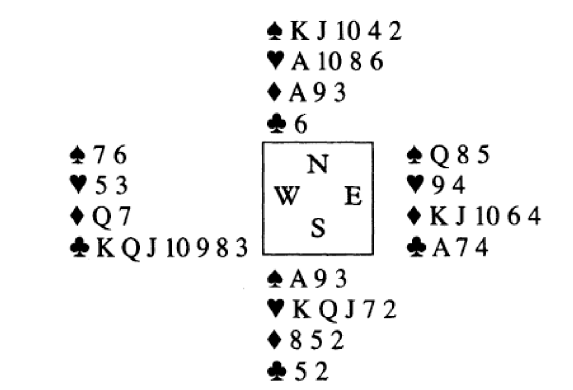BRIDGE ON THE RADIO USA, OCTOBER 1926
Each player should take the name of one of the experts and occupy his place at the table. So started one particular episode of a bridge series that was broadcast on various radio stations amend the United States.
The experts on this occasion were Sidney Lenz, E V Shepard, Wilbur Whitehead and Milton Work. You should have a pack of cards on the table which is divided into suits, an that the cards of each suit may be easily and quickly selected and handed to the proper player. Spread the four suits out on the table, face up, with each suit arranged in sequence, two, three, four, five, six, seven, eight, nine, ten, jack, queen, king and ace.
Dealer North
West North East South

Each bid was accompanied by a lengthy description of what was happening in the expert’s mind. Then the listeners were given the next instruction.
Each player should now play each card as it is called, placing it immediately in front of him on the table, an that his hand is kept intact. Please do not gather your cards in tricks, but place them in front of you face up.
East led ![]() 4. South (Whitehead) put down dummy and North (Lenz) studied his options before losing this first trick. He knew he had one club loser, two diamond losers and possibly a spade.
4. South (Whitehead) put down dummy and North (Lenz) studied his options before losing this first trick. He knew he had one club loser, two diamond losers and possibly a spade.
Lenz won the diamond return with dummy’s ace and then set about two rounds of hearts, ending in his hand. He ruffed a club and led ![]() 3 to East’s
3 to East’s ![]() K. After a second diamond, East was forced to lead a spade, a club or a diamond.
K. After a second diamond, East was forced to lead a spade, a club or a diamond.
None of them would help the defence. Declarer could either trump in dummy and discard his spade loser, or promote dummy’s ![]() J. Similarly, if West takes the diamond trick, his next lead ensures the contract makes.
J. Similarly, if West takes the diamond trick, his next lead ensures the contract makes.
The radio programme then summarised the unusual features of the hand, ending with the week’s major lesson:
[box type=»info»]This procedure of first taking out the cards of at least two suits in order to force a lead of one of the other two, the avoidance of the finesse, and the throwing of the lead to one of the opponents is ordinary practice in advance play, and is called stripping the hand.[/box]
It wasn’t a particularly strange hand in itself. What was strange was its dissemination to so many Americans.
